An Analysis of Consumer Choice Theory: Economics Report
VerifiedAdded on 2023/03/21
|10
|2747
|42
Report
AI Summary
This report delves into consumer choice theory, a microeconomic concept that explains how individuals make consumption choices based on factors like income and prices. It explores key concepts such as indifference curves, which represent different combinations of goods providing the same level of satisfaction; consumer equilibrium, where consumers maximize utility within budget constraints; and consumer surplus, which measures the benefit consumers receive beyond what they pay. The report examines impulsive and compulsive consumption behaviors within this framework. By applying theory and cases, the report identifies the factors that motivate individuals to consume goods and services, ultimately impacting the demand curve and the overall economy. The analysis references key literature and provides a comprehensive overview of consumer behavior and decision-making processes in the context of economics.
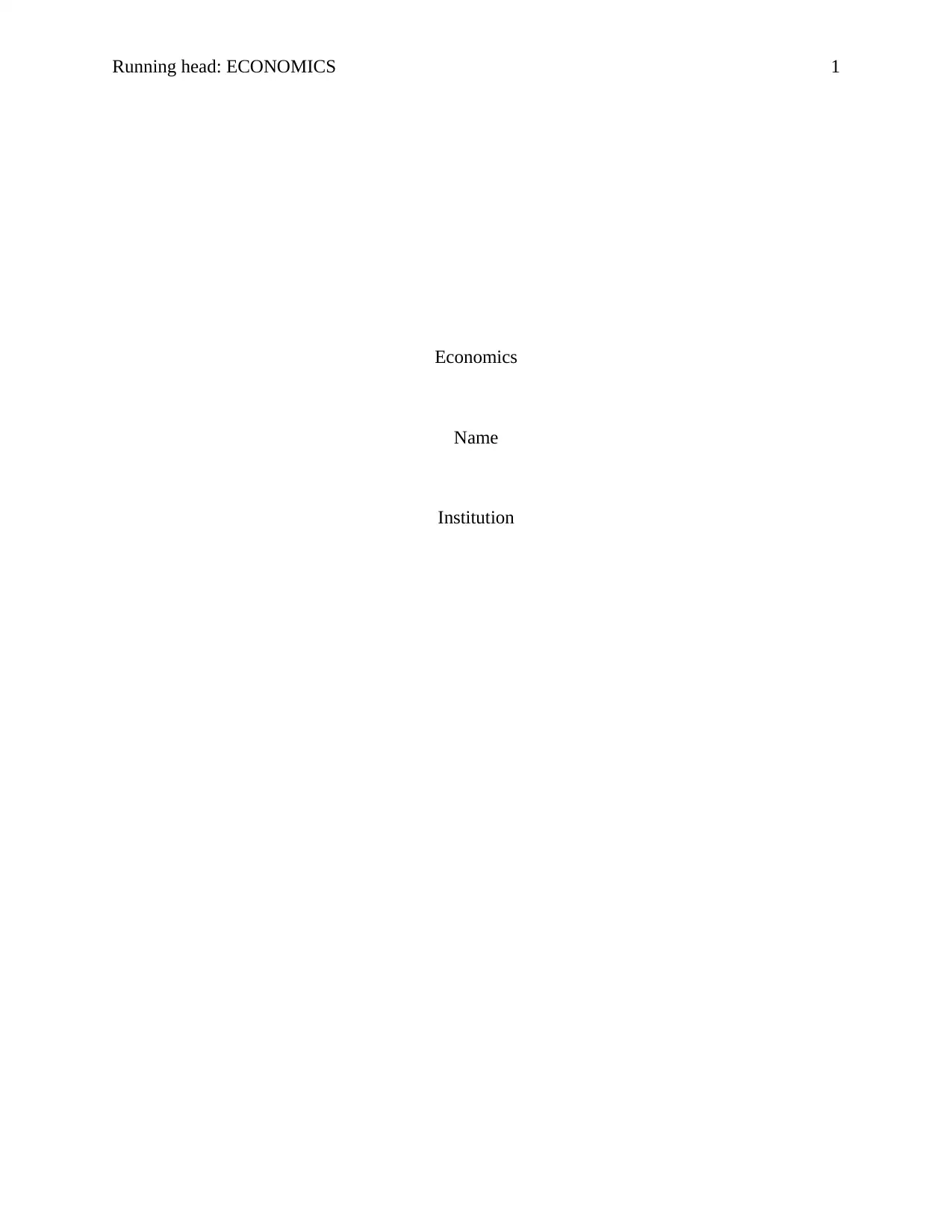
Running head: ECONOMICS 1
Economics
Name
Institution
Economics
Name
Institution
Paraphrase This Document
Need a fresh take? Get an instant paraphrase of this document with our AI Paraphraser
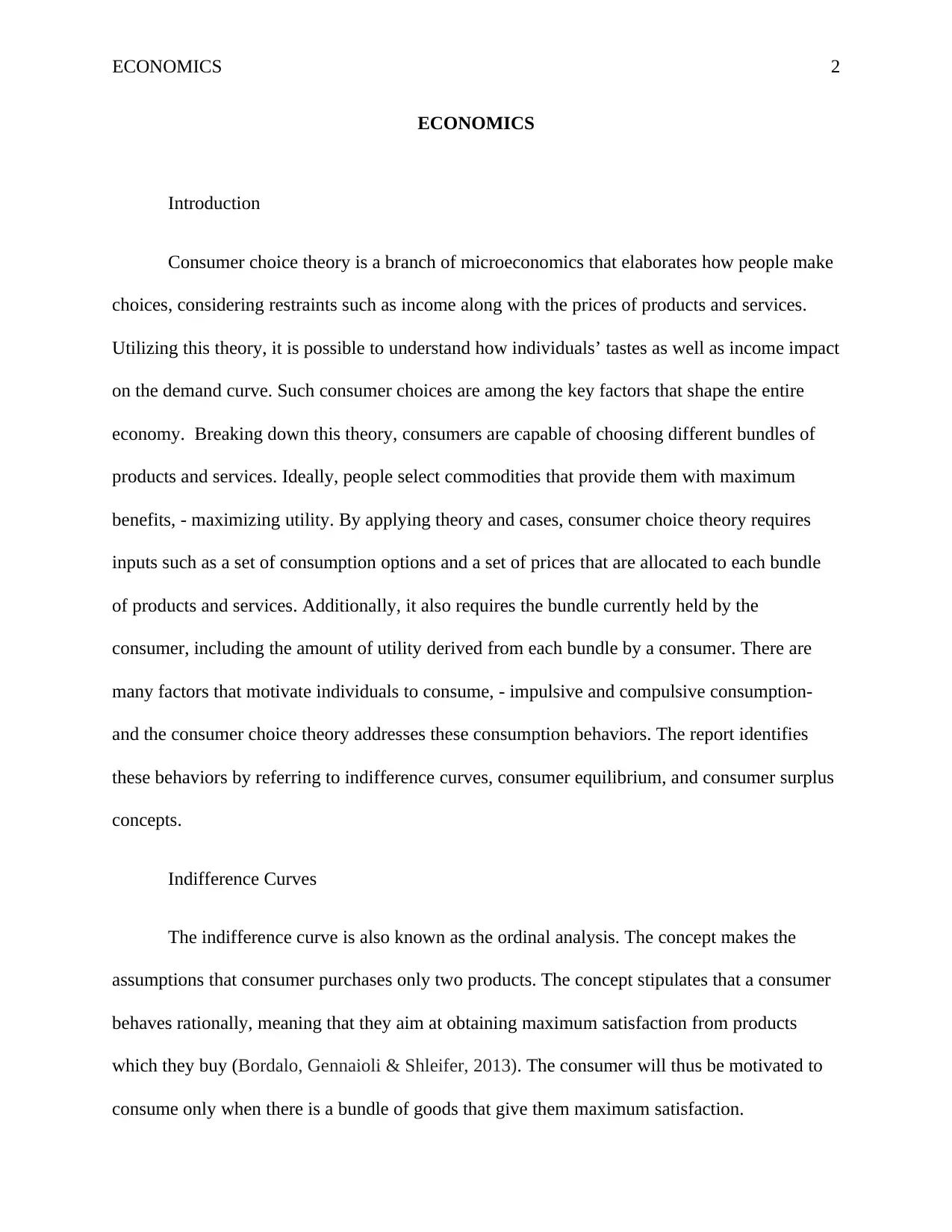
ECONOMICS 2
ECONOMICS
Introduction
Consumer choice theory is a branch of microeconomics that elaborates how people make
choices, considering restraints such as income along with the prices of products and services.
Utilizing this theory, it is possible to understand how individuals’ tastes as well as income impact
on the demand curve. Such consumer choices are among the key factors that shape the entire
economy. Breaking down this theory, consumers are capable of choosing different bundles of
products and services. Ideally, people select commodities that provide them with maximum
benefits, - maximizing utility. By applying theory and cases, consumer choice theory requires
inputs such as a set of consumption options and a set of prices that are allocated to each bundle
of products and services. Additionally, it also requires the bundle currently held by the
consumer, including the amount of utility derived from each bundle by a consumer. There are
many factors that motivate individuals to consume, - impulsive and compulsive consumption-
and the consumer choice theory addresses these consumption behaviors. The report identifies
these behaviors by referring to indifference curves, consumer equilibrium, and consumer surplus
concepts.
Indifference Curves
The indifference curve is also known as the ordinal analysis. The concept makes the
assumptions that consumer purchases only two products. The concept stipulates that a consumer
behaves rationally, meaning that they aim at obtaining maximum satisfaction from products
which they buy (Bordalo, Gennaioli & Shleifer, 2013). The consumer will thus be motivated to
consume only when there is a bundle of goods that give them maximum satisfaction.
ECONOMICS
Introduction
Consumer choice theory is a branch of microeconomics that elaborates how people make
choices, considering restraints such as income along with the prices of products and services.
Utilizing this theory, it is possible to understand how individuals’ tastes as well as income impact
on the demand curve. Such consumer choices are among the key factors that shape the entire
economy. Breaking down this theory, consumers are capable of choosing different bundles of
products and services. Ideally, people select commodities that provide them with maximum
benefits, - maximizing utility. By applying theory and cases, consumer choice theory requires
inputs such as a set of consumption options and a set of prices that are allocated to each bundle
of products and services. Additionally, it also requires the bundle currently held by the
consumer, including the amount of utility derived from each bundle by a consumer. There are
many factors that motivate individuals to consume, - impulsive and compulsive consumption-
and the consumer choice theory addresses these consumption behaviors. The report identifies
these behaviors by referring to indifference curves, consumer equilibrium, and consumer surplus
concepts.
Indifference Curves
The indifference curve is also known as the ordinal analysis. The concept makes the
assumptions that consumer purchases only two products. The concept stipulates that a consumer
behaves rationally, meaning that they aim at obtaining maximum satisfaction from products
which they buy (Bordalo, Gennaioli & Shleifer, 2013). The consumer will thus be motivated to
consume only when there is a bundle of goods that give them maximum satisfaction.
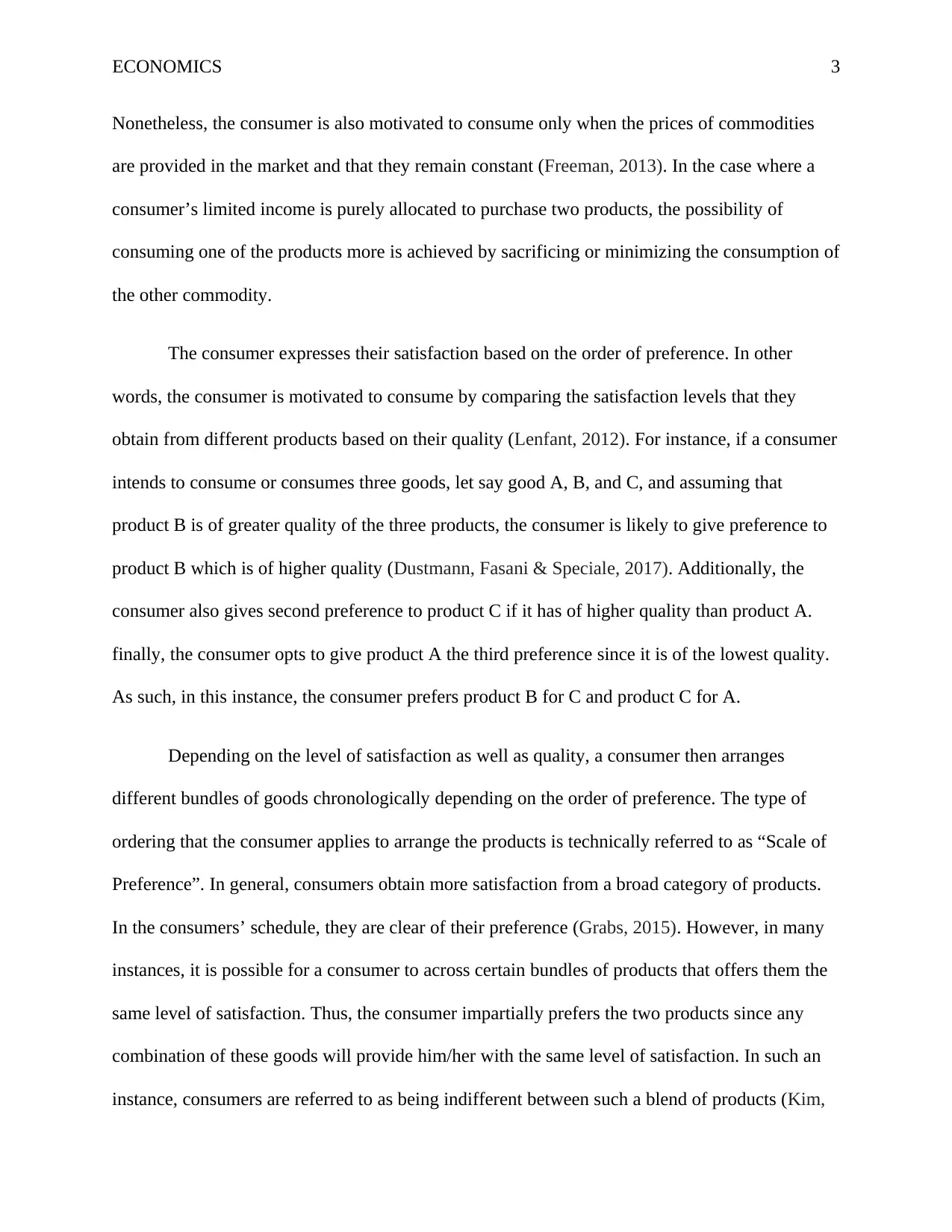
ECONOMICS 3
Nonetheless, the consumer is also motivated to consume only when the prices of commodities
are provided in the market and that they remain constant (Freeman, 2013). In the case where a
consumer’s limited income is purely allocated to purchase two products, the possibility of
consuming one of the products more is achieved by sacrificing or minimizing the consumption of
the other commodity.
The consumer expresses their satisfaction based on the order of preference. In other
words, the consumer is motivated to consume by comparing the satisfaction levels that they
obtain from different products based on their quality (Lenfant, 2012). For instance, if a consumer
intends to consume or consumes three goods, let say good A, B, and C, and assuming that
product B is of greater quality of the three products, the consumer is likely to give preference to
product B which is of higher quality (Dustmann, Fasani & Speciale, 2017). Additionally, the
consumer also gives second preference to product C if it has of higher quality than product A.
finally, the consumer opts to give product A the third preference since it is of the lowest quality.
As such, in this instance, the consumer prefers product B for C and product C for A.
Depending on the level of satisfaction as well as quality, a consumer then arranges
different bundles of goods chronologically depending on the order of preference. The type of
ordering that the consumer applies to arrange the products is technically referred to as “Scale of
Preference”. In general, consumers obtain more satisfaction from a broad category of products.
In the consumers’ schedule, they are clear of their preference (Grabs, 2015). However, in many
instances, it is possible for a consumer to across certain bundles of products that offers them the
same level of satisfaction. Thus, the consumer impartially prefers the two products since any
combination of these goods will provide him/her with the same level of satisfaction. In such an
instance, consumers are referred to as being indifferent between such a blend of products (Kim,
Nonetheless, the consumer is also motivated to consume only when the prices of commodities
are provided in the market and that they remain constant (Freeman, 2013). In the case where a
consumer’s limited income is purely allocated to purchase two products, the possibility of
consuming one of the products more is achieved by sacrificing or minimizing the consumption of
the other commodity.
The consumer expresses their satisfaction based on the order of preference. In other
words, the consumer is motivated to consume by comparing the satisfaction levels that they
obtain from different products based on their quality (Lenfant, 2012). For instance, if a consumer
intends to consume or consumes three goods, let say good A, B, and C, and assuming that
product B is of greater quality of the three products, the consumer is likely to give preference to
product B which is of higher quality (Dustmann, Fasani & Speciale, 2017). Additionally, the
consumer also gives second preference to product C if it has of higher quality than product A.
finally, the consumer opts to give product A the third preference since it is of the lowest quality.
As such, in this instance, the consumer prefers product B for C and product C for A.
Depending on the level of satisfaction as well as quality, a consumer then arranges
different bundles of goods chronologically depending on the order of preference. The type of
ordering that the consumer applies to arrange the products is technically referred to as “Scale of
Preference”. In general, consumers obtain more satisfaction from a broad category of products.
In the consumers’ schedule, they are clear of their preference (Grabs, 2015). However, in many
instances, it is possible for a consumer to across certain bundles of products that offers them the
same level of satisfaction. Thus, the consumer impartially prefers the two products since any
combination of these goods will provide him/her with the same level of satisfaction. In such an
instance, consumers are referred to as being indifferent between such a blend of products (Kim,
⊘ This is a preview!⊘
Do you want full access?
Subscribe today to unlock all pages.

Trusted by 1+ million students worldwide
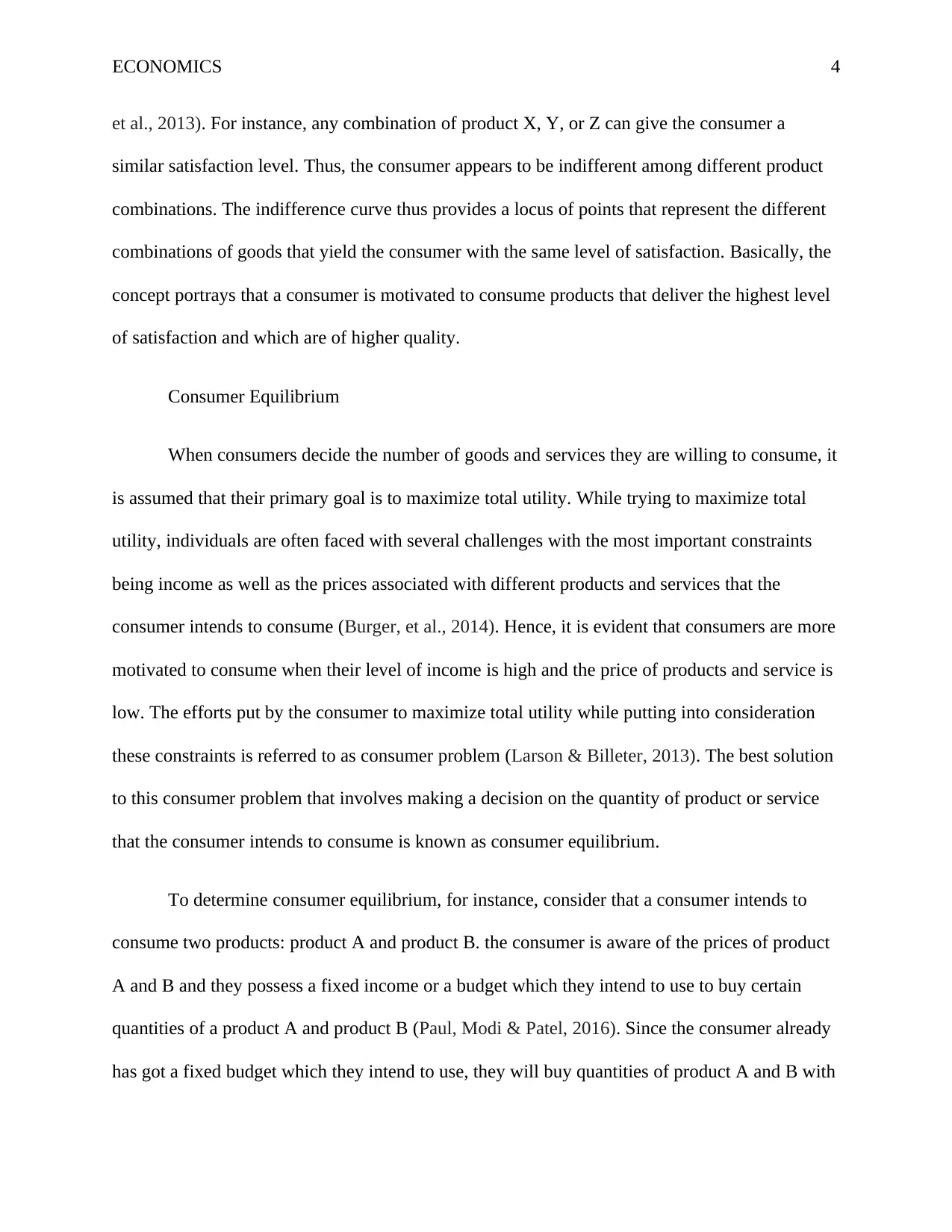
ECONOMICS 4
et al., 2013). For instance, any combination of product X, Y, or Z can give the consumer a
similar satisfaction level. Thus, the consumer appears to be indifferent among different product
combinations. The indifference curve thus provides a locus of points that represent the different
combinations of goods that yield the consumer with the same level of satisfaction. Basically, the
concept portrays that a consumer is motivated to consume products that deliver the highest level
of satisfaction and which are of higher quality.
Consumer Equilibrium
When consumers decide the number of goods and services they are willing to consume, it
is assumed that their primary goal is to maximize total utility. While trying to maximize total
utility, individuals are often faced with several challenges with the most important constraints
being income as well as the prices associated with different products and services that the
consumer intends to consume (Burger, et al., 2014). Hence, it is evident that consumers are more
motivated to consume when their level of income is high and the price of products and service is
low. The efforts put by the consumer to maximize total utility while putting into consideration
these constraints is referred to as consumer problem (Larson & Billeter, 2013). The best solution
to this consumer problem that involves making a decision on the quantity of product or service
that the consumer intends to consume is known as consumer equilibrium.
To determine consumer equilibrium, for instance, consider that a consumer intends to
consume two products: product A and product B. the consumer is aware of the prices of product
A and B and they possess a fixed income or a budget which they intend to use to buy certain
quantities of a product A and product B (Paul, Modi & Patel, 2016). Since the consumer already
has got a fixed budget which they intend to use, they will buy quantities of product A and B with
et al., 2013). For instance, any combination of product X, Y, or Z can give the consumer a
similar satisfaction level. Thus, the consumer appears to be indifferent among different product
combinations. The indifference curve thus provides a locus of points that represent the different
combinations of goods that yield the consumer with the same level of satisfaction. Basically, the
concept portrays that a consumer is motivated to consume products that deliver the highest level
of satisfaction and which are of higher quality.
Consumer Equilibrium
When consumers decide the number of goods and services they are willing to consume, it
is assumed that their primary goal is to maximize total utility. While trying to maximize total
utility, individuals are often faced with several challenges with the most important constraints
being income as well as the prices associated with different products and services that the
consumer intends to consume (Burger, et al., 2014). Hence, it is evident that consumers are more
motivated to consume when their level of income is high and the price of products and service is
low. The efforts put by the consumer to maximize total utility while putting into consideration
these constraints is referred to as consumer problem (Larson & Billeter, 2013). The best solution
to this consumer problem that involves making a decision on the quantity of product or service
that the consumer intends to consume is known as consumer equilibrium.
To determine consumer equilibrium, for instance, consider that a consumer intends to
consume two products: product A and product B. the consumer is aware of the prices of product
A and B and they possess a fixed income or a budget which they intend to use to buy certain
quantities of a product A and product B (Paul, Modi & Patel, 2016). Since the consumer already
has got a fixed budget which they intend to use, they will buy quantities of product A and B with
Paraphrase This Document
Need a fresh take? Get an instant paraphrase of this document with our AI Paraphraser
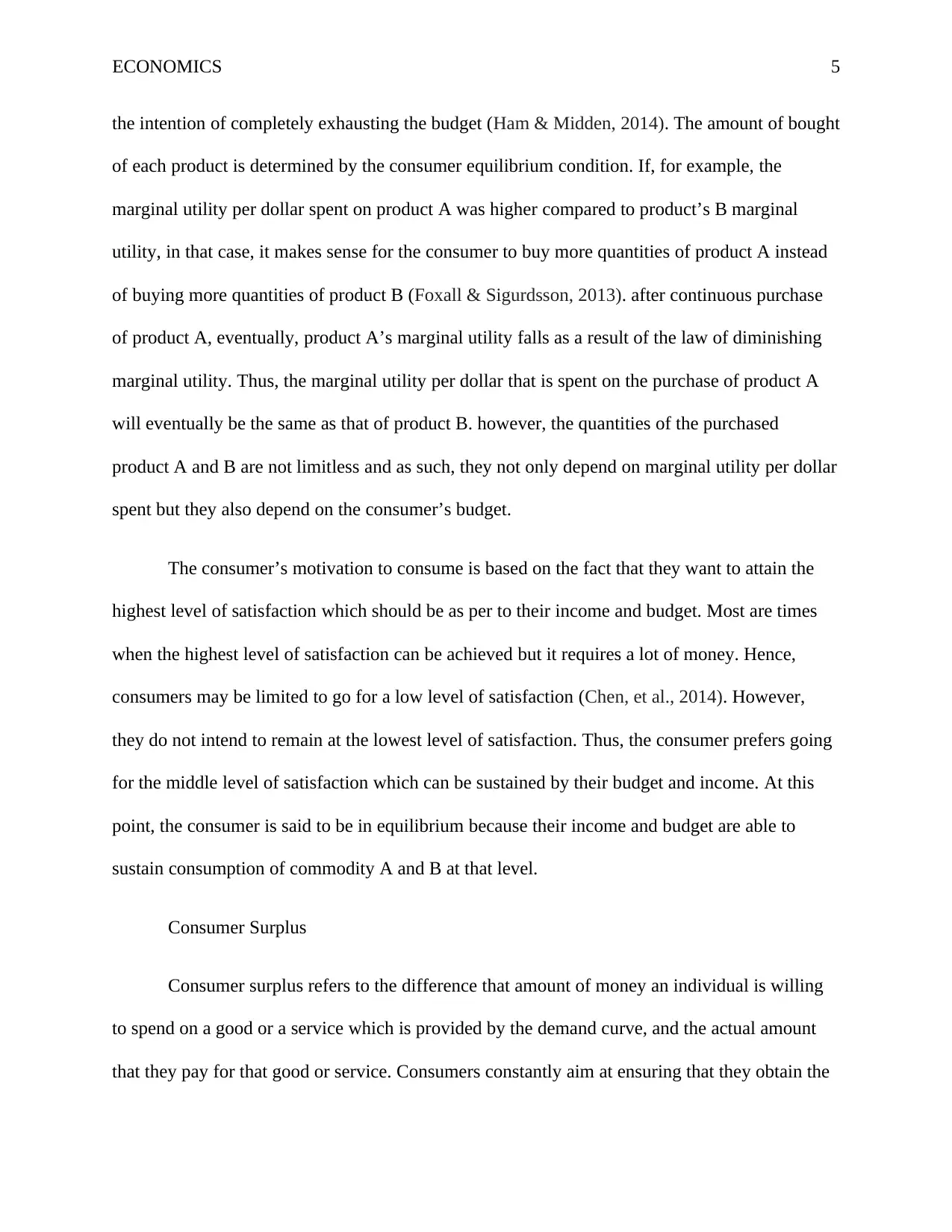
ECONOMICS 5
the intention of completely exhausting the budget (Ham & Midden, 2014). The amount of bought
of each product is determined by the consumer equilibrium condition. If, for example, the
marginal utility per dollar spent on product A was higher compared to product’s B marginal
utility, in that case, it makes sense for the consumer to buy more quantities of product A instead
of buying more quantities of product B (Foxall & Sigurdsson, 2013). after continuous purchase
of product A, eventually, product A’s marginal utility falls as a result of the law of diminishing
marginal utility. Thus, the marginal utility per dollar that is spent on the purchase of product A
will eventually be the same as that of product B. however, the quantities of the purchased
product A and B are not limitless and as such, they not only depend on marginal utility per dollar
spent but they also depend on the consumer’s budget.
The consumer’s motivation to consume is based on the fact that they want to attain the
highest level of satisfaction which should be as per to their income and budget. Most are times
when the highest level of satisfaction can be achieved but it requires a lot of money. Hence,
consumers may be limited to go for a low level of satisfaction (Chen, et al., 2014). However,
they do not intend to remain at the lowest level of satisfaction. Thus, the consumer prefers going
for the middle level of satisfaction which can be sustained by their budget and income. At this
point, the consumer is said to be in equilibrium because their income and budget are able to
sustain consumption of commodity A and B at that level.
Consumer Surplus
Consumer surplus refers to the difference that amount of money an individual is willing
to spend on a good or a service which is provided by the demand curve, and the actual amount
that they pay for that good or service. Consumers constantly aim at ensuring that they obtain the
the intention of completely exhausting the budget (Ham & Midden, 2014). The amount of bought
of each product is determined by the consumer equilibrium condition. If, for example, the
marginal utility per dollar spent on product A was higher compared to product’s B marginal
utility, in that case, it makes sense for the consumer to buy more quantities of product A instead
of buying more quantities of product B (Foxall & Sigurdsson, 2013). after continuous purchase
of product A, eventually, product A’s marginal utility falls as a result of the law of diminishing
marginal utility. Thus, the marginal utility per dollar that is spent on the purchase of product A
will eventually be the same as that of product B. however, the quantities of the purchased
product A and B are not limitless and as such, they not only depend on marginal utility per dollar
spent but they also depend on the consumer’s budget.
The consumer’s motivation to consume is based on the fact that they want to attain the
highest level of satisfaction which should be as per to their income and budget. Most are times
when the highest level of satisfaction can be achieved but it requires a lot of money. Hence,
consumers may be limited to go for a low level of satisfaction (Chen, et al., 2014). However,
they do not intend to remain at the lowest level of satisfaction. Thus, the consumer prefers going
for the middle level of satisfaction which can be sustained by their budget and income. At this
point, the consumer is said to be in equilibrium because their income and budget are able to
sustain consumption of commodity A and B at that level.
Consumer Surplus
Consumer surplus refers to the difference that amount of money an individual is willing
to spend on a good or a service which is provided by the demand curve, and the actual amount
that they pay for that good or service. Consumers constantly aim at ensuring that they obtain the
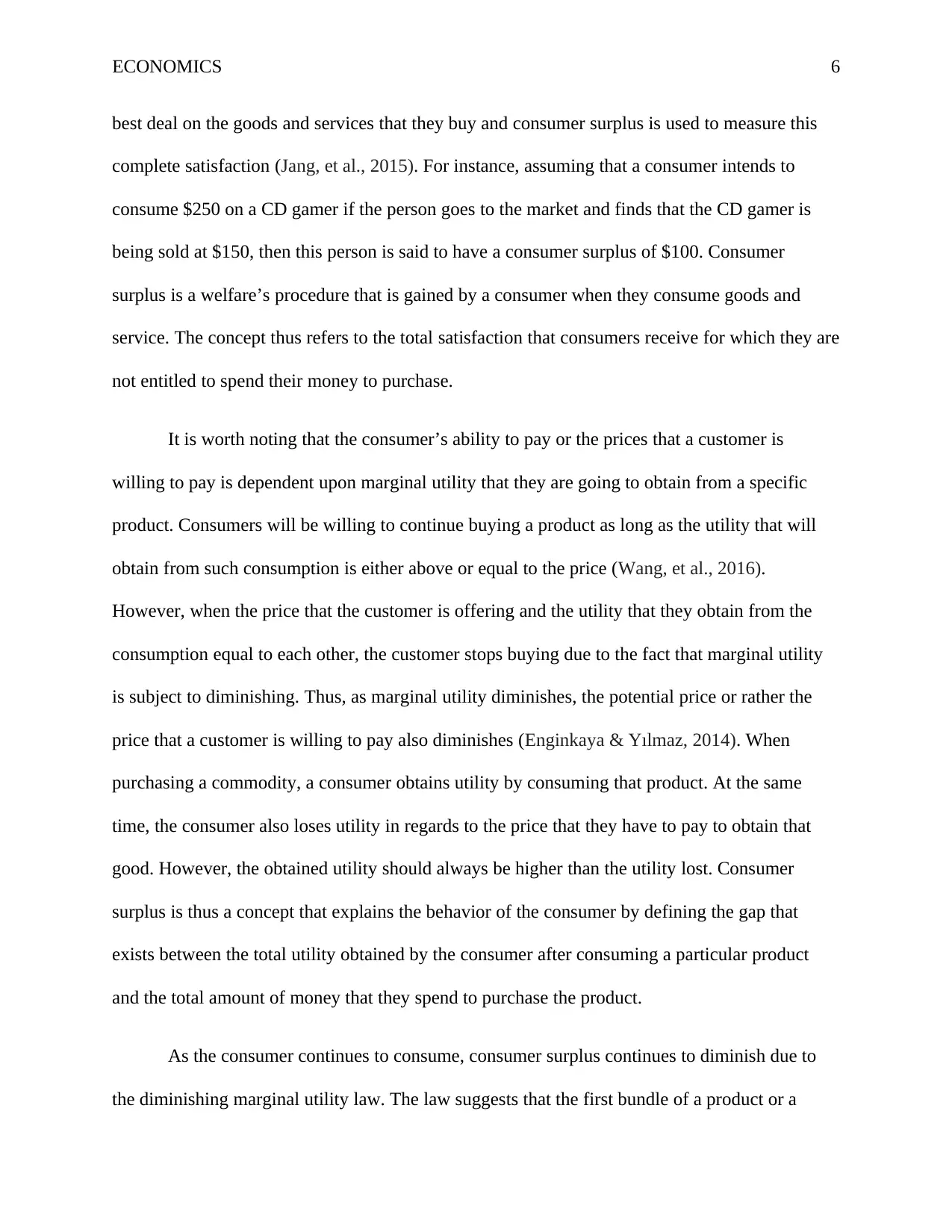
ECONOMICS 6
best deal on the goods and services that they buy and consumer surplus is used to measure this
complete satisfaction (Jang, et al., 2015). For instance, assuming that a consumer intends to
consume $250 on a CD gamer if the person goes to the market and finds that the CD gamer is
being sold at $150, then this person is said to have a consumer surplus of $100. Consumer
surplus is a welfare’s procedure that is gained by a consumer when they consume goods and
service. The concept thus refers to the total satisfaction that consumers receive for which they are
not entitled to spend their money to purchase.
It is worth noting that the consumer’s ability to pay or the prices that a customer is
willing to pay is dependent upon marginal utility that they are going to obtain from a specific
product. Consumers will be willing to continue buying a product as long as the utility that will
obtain from such consumption is either above or equal to the price (Wang, et al., 2016).
However, when the price that the customer is offering and the utility that they obtain from the
consumption equal to each other, the customer stops buying due to the fact that marginal utility
is subject to diminishing. Thus, as marginal utility diminishes, the potential price or rather the
price that a customer is willing to pay also diminishes (Enginkaya & Yılmaz, 2014). When
purchasing a commodity, a consumer obtains utility by consuming that product. At the same
time, the consumer also loses utility in regards to the price that they have to pay to obtain that
good. However, the obtained utility should always be higher than the utility lost. Consumer
surplus is thus a concept that explains the behavior of the consumer by defining the gap that
exists between the total utility obtained by the consumer after consuming a particular product
and the total amount of money that they spend to purchase the product.
As the consumer continues to consume, consumer surplus continues to diminish due to
the diminishing marginal utility law. The law suggests that the first bundle of a product or a
best deal on the goods and services that they buy and consumer surplus is used to measure this
complete satisfaction (Jang, et al., 2015). For instance, assuming that a consumer intends to
consume $250 on a CD gamer if the person goes to the market and finds that the CD gamer is
being sold at $150, then this person is said to have a consumer surplus of $100. Consumer
surplus is a welfare’s procedure that is gained by a consumer when they consume goods and
service. The concept thus refers to the total satisfaction that consumers receive for which they are
not entitled to spend their money to purchase.
It is worth noting that the consumer’s ability to pay or the prices that a customer is
willing to pay is dependent upon marginal utility that they are going to obtain from a specific
product. Consumers will be willing to continue buying a product as long as the utility that will
obtain from such consumption is either above or equal to the price (Wang, et al., 2016).
However, when the price that the customer is offering and the utility that they obtain from the
consumption equal to each other, the customer stops buying due to the fact that marginal utility
is subject to diminishing. Thus, as marginal utility diminishes, the potential price or rather the
price that a customer is willing to pay also diminishes (Enginkaya & Yılmaz, 2014). When
purchasing a commodity, a consumer obtains utility by consuming that product. At the same
time, the consumer also loses utility in regards to the price that they have to pay to obtain that
good. However, the obtained utility should always be higher than the utility lost. Consumer
surplus is thus a concept that explains the behavior of the consumer by defining the gap that
exists between the total utility obtained by the consumer after consuming a particular product
and the total amount of money that they spend to purchase the product.
As the consumer continues to consume, consumer surplus continues to diminish due to
the diminishing marginal utility law. The law suggests that the first bundle of a product or a
⊘ This is a preview!⊘
Do you want full access?
Subscribe today to unlock all pages.

Trusted by 1+ million students worldwide
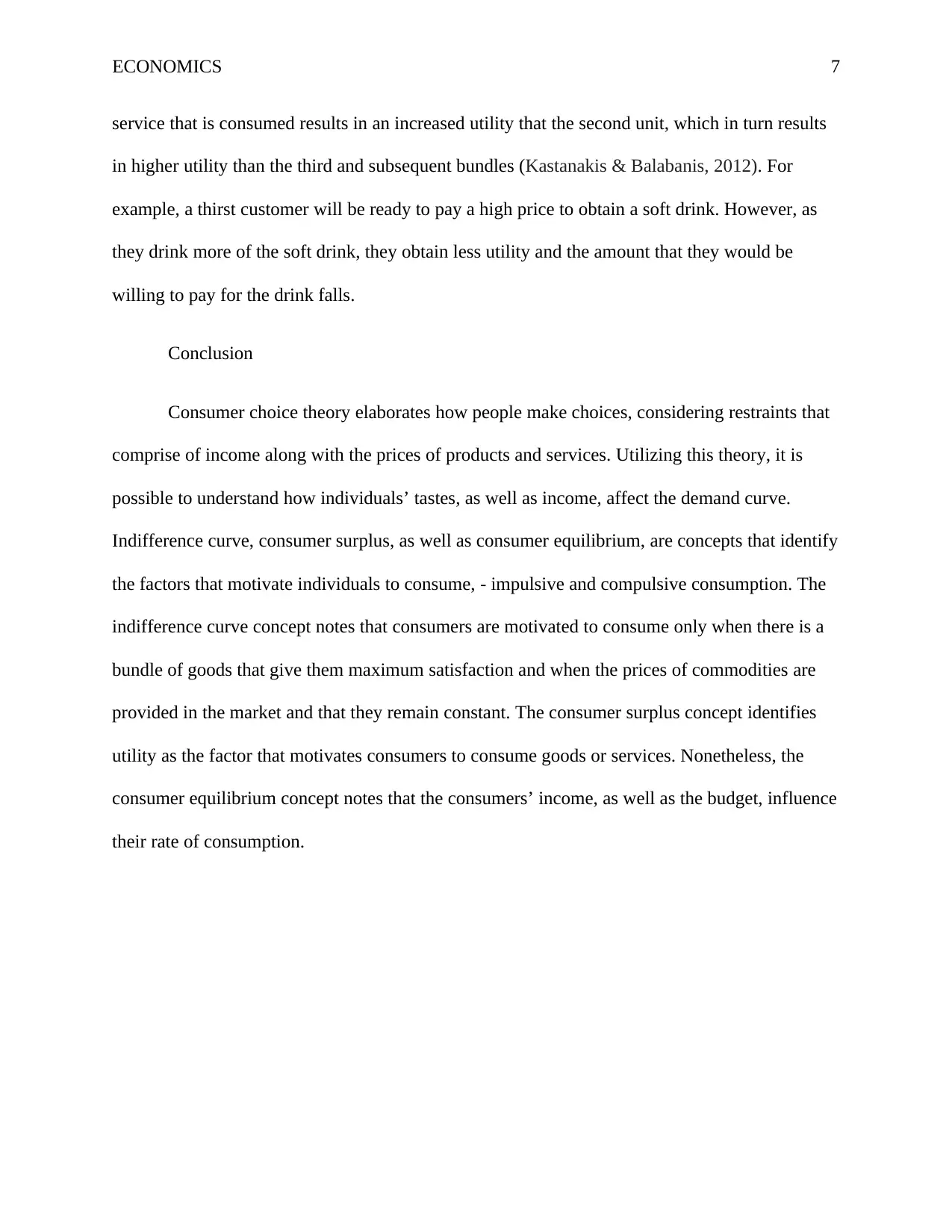
ECONOMICS 7
service that is consumed results in an increased utility that the second unit, which in turn results
in higher utility than the third and subsequent bundles (Kastanakis & Balabanis, 2012). For
example, a thirst customer will be ready to pay a high price to obtain a soft drink. However, as
they drink more of the soft drink, they obtain less utility and the amount that they would be
willing to pay for the drink falls.
Conclusion
Consumer choice theory elaborates how people make choices, considering restraints that
comprise of income along with the prices of products and services. Utilizing this theory, it is
possible to understand how individuals’ tastes, as well as income, affect the demand curve.
Indifference curve, consumer surplus, as well as consumer equilibrium, are concepts that identify
the factors that motivate individuals to consume, - impulsive and compulsive consumption. The
indifference curve concept notes that consumers are motivated to consume only when there is a
bundle of goods that give them maximum satisfaction and when the prices of commodities are
provided in the market and that they remain constant. The consumer surplus concept identifies
utility as the factor that motivates consumers to consume goods or services. Nonetheless, the
consumer equilibrium concept notes that the consumers’ income, as well as the budget, influence
their rate of consumption.
service that is consumed results in an increased utility that the second unit, which in turn results
in higher utility than the third and subsequent bundles (Kastanakis & Balabanis, 2012). For
example, a thirst customer will be ready to pay a high price to obtain a soft drink. However, as
they drink more of the soft drink, they obtain less utility and the amount that they would be
willing to pay for the drink falls.
Conclusion
Consumer choice theory elaborates how people make choices, considering restraints that
comprise of income along with the prices of products and services. Utilizing this theory, it is
possible to understand how individuals’ tastes, as well as income, affect the demand curve.
Indifference curve, consumer surplus, as well as consumer equilibrium, are concepts that identify
the factors that motivate individuals to consume, - impulsive and compulsive consumption. The
indifference curve concept notes that consumers are motivated to consume only when there is a
bundle of goods that give them maximum satisfaction and when the prices of commodities are
provided in the market and that they remain constant. The consumer surplus concept identifies
utility as the factor that motivates consumers to consume goods or services. Nonetheless, the
consumer equilibrium concept notes that the consumers’ income, as well as the budget, influence
their rate of consumption.
Paraphrase This Document
Need a fresh take? Get an instant paraphrase of this document with our AI Paraphraser
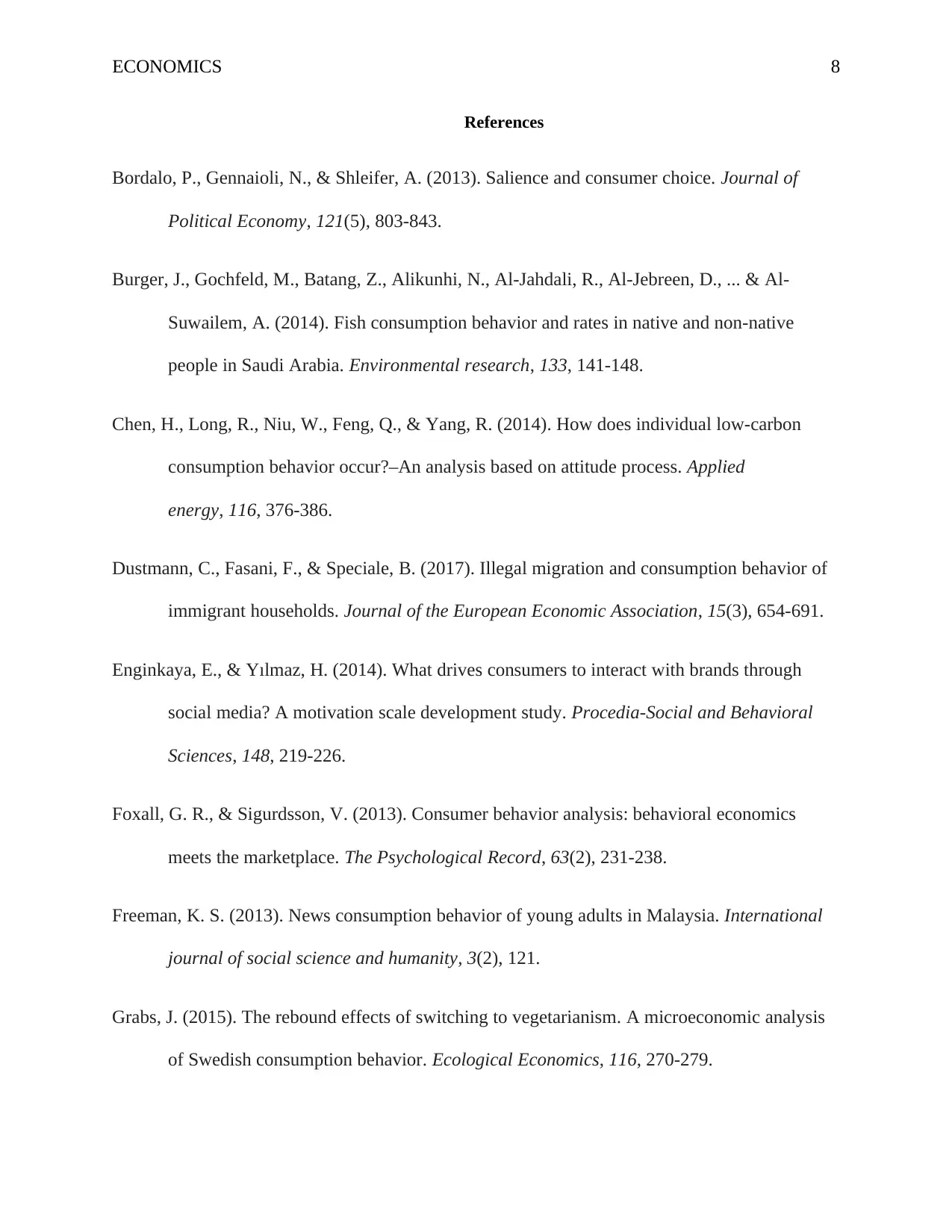
ECONOMICS 8
References
Bordalo, P., Gennaioli, N., & Shleifer, A. (2013). Salience and consumer choice. Journal of
Political Economy, 121(5), 803-843.
Burger, J., Gochfeld, M., Batang, Z., Alikunhi, N., Al-Jahdali, R., Al-Jebreen, D., ... & Al-
Suwailem, A. (2014). Fish consumption behavior and rates in native and non-native
people in Saudi Arabia. Environmental research, 133, 141-148.
Chen, H., Long, R., Niu, W., Feng, Q., & Yang, R. (2014). How does individual low-carbon
consumption behavior occur?–An analysis based on attitude process. Applied
energy, 116, 376-386.
Dustmann, C., Fasani, F., & Speciale, B. (2017). Illegal migration and consumption behavior of
immigrant households. Journal of the European Economic Association, 15(3), 654-691.
Enginkaya, E., & Yılmaz, H. (2014). What drives consumers to interact with brands through
social media? A motivation scale development study. Procedia-Social and Behavioral
Sciences, 148, 219-226.
Foxall, G. R., & Sigurdsson, V. (2013). Consumer behavior analysis: behavioral economics
meets the marketplace. The Psychological Record, 63(2), 231-238.
Freeman, K. S. (2013). News consumption behavior of young adults in Malaysia. International
journal of social science and humanity, 3(2), 121.
Grabs, J. (2015). The rebound effects of switching to vegetarianism. A microeconomic analysis
of Swedish consumption behavior. Ecological Economics, 116, 270-279.
References
Bordalo, P., Gennaioli, N., & Shleifer, A. (2013). Salience and consumer choice. Journal of
Political Economy, 121(5), 803-843.
Burger, J., Gochfeld, M., Batang, Z., Alikunhi, N., Al-Jahdali, R., Al-Jebreen, D., ... & Al-
Suwailem, A. (2014). Fish consumption behavior and rates in native and non-native
people in Saudi Arabia. Environmental research, 133, 141-148.
Chen, H., Long, R., Niu, W., Feng, Q., & Yang, R. (2014). How does individual low-carbon
consumption behavior occur?–An analysis based on attitude process. Applied
energy, 116, 376-386.
Dustmann, C., Fasani, F., & Speciale, B. (2017). Illegal migration and consumption behavior of
immigrant households. Journal of the European Economic Association, 15(3), 654-691.
Enginkaya, E., & Yılmaz, H. (2014). What drives consumers to interact with brands through
social media? A motivation scale development study. Procedia-Social and Behavioral
Sciences, 148, 219-226.
Foxall, G. R., & Sigurdsson, V. (2013). Consumer behavior analysis: behavioral economics
meets the marketplace. The Psychological Record, 63(2), 231-238.
Freeman, K. S. (2013). News consumption behavior of young adults in Malaysia. International
journal of social science and humanity, 3(2), 121.
Grabs, J. (2015). The rebound effects of switching to vegetarianism. A microeconomic analysis
of Swedish consumption behavior. Ecological Economics, 116, 270-279.
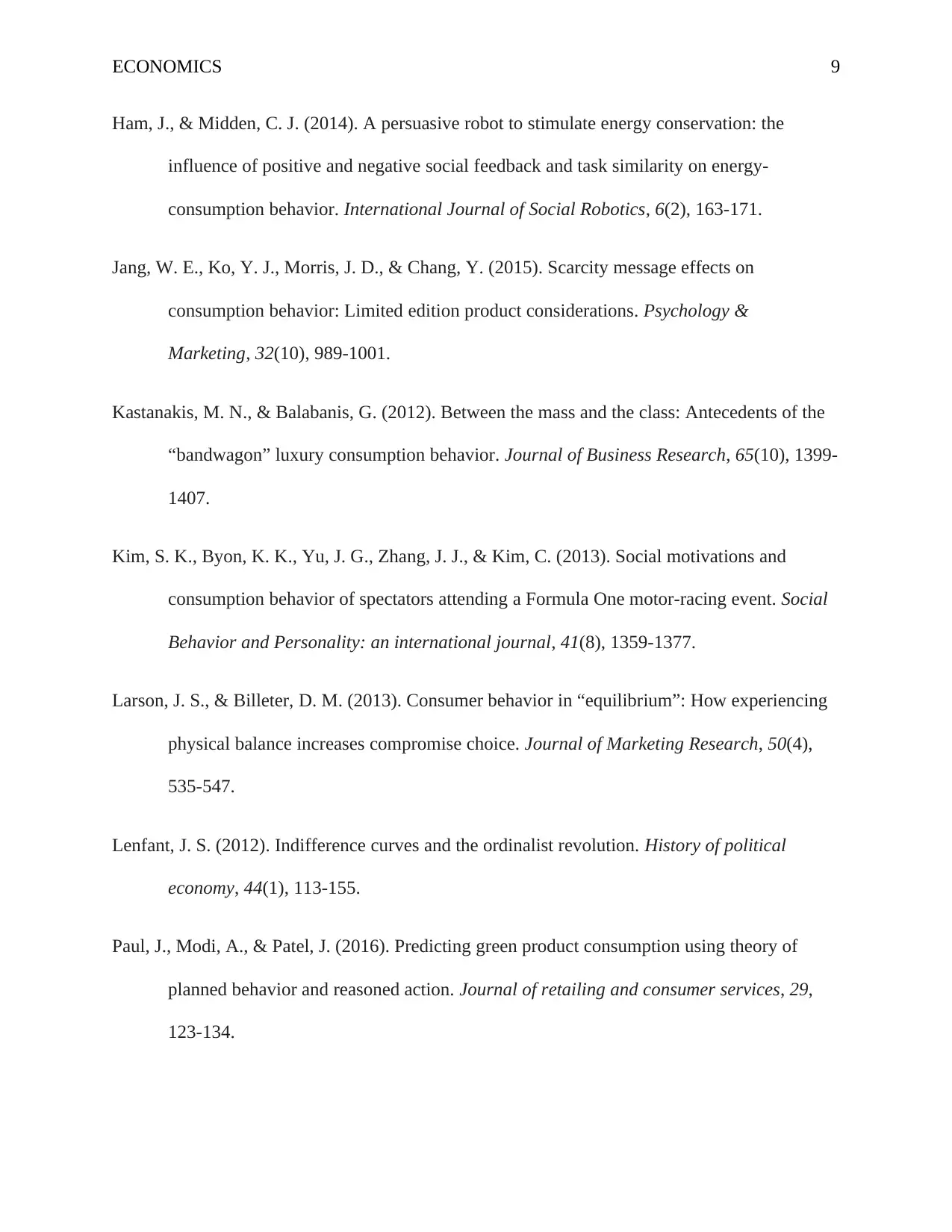
ECONOMICS 9
Ham, J., & Midden, C. J. (2014). A persuasive robot to stimulate energy conservation: the
influence of positive and negative social feedback and task similarity on energy-
consumption behavior. International Journal of Social Robotics, 6(2), 163-171.
Jang, W. E., Ko, Y. J., Morris, J. D., & Chang, Y. (2015). Scarcity message effects on
consumption behavior: Limited edition product considerations. Psychology &
Marketing, 32(10), 989-1001.
Kastanakis, M. N., & Balabanis, G. (2012). Between the mass and the class: Antecedents of the
“bandwagon” luxury consumption behavior. Journal of Business Research, 65(10), 1399-
1407.
Kim, S. K., Byon, K. K., Yu, J. G., Zhang, J. J., & Kim, C. (2013). Social motivations and
consumption behavior of spectators attending a Formula One motor-racing event. Social
Behavior and Personality: an international journal, 41(8), 1359-1377.
Larson, J. S., & Billeter, D. M. (2013). Consumer behavior in “equilibrium”: How experiencing
physical balance increases compromise choice. Journal of Marketing Research, 50(4),
535-547.
Lenfant, J. S. (2012). Indifference curves and the ordinalist revolution. History of political
economy, 44(1), 113-155.
Paul, J., Modi, A., & Patel, J. (2016). Predicting green product consumption using theory of
planned behavior and reasoned action. Journal of retailing and consumer services, 29,
123-134.
Ham, J., & Midden, C. J. (2014). A persuasive robot to stimulate energy conservation: the
influence of positive and negative social feedback and task similarity on energy-
consumption behavior. International Journal of Social Robotics, 6(2), 163-171.
Jang, W. E., Ko, Y. J., Morris, J. D., & Chang, Y. (2015). Scarcity message effects on
consumption behavior: Limited edition product considerations. Psychology &
Marketing, 32(10), 989-1001.
Kastanakis, M. N., & Balabanis, G. (2012). Between the mass and the class: Antecedents of the
“bandwagon” luxury consumption behavior. Journal of Business Research, 65(10), 1399-
1407.
Kim, S. K., Byon, K. K., Yu, J. G., Zhang, J. J., & Kim, C. (2013). Social motivations and
consumption behavior of spectators attending a Formula One motor-racing event. Social
Behavior and Personality: an international journal, 41(8), 1359-1377.
Larson, J. S., & Billeter, D. M. (2013). Consumer behavior in “equilibrium”: How experiencing
physical balance increases compromise choice. Journal of Marketing Research, 50(4),
535-547.
Lenfant, J. S. (2012). Indifference curves and the ordinalist revolution. History of political
economy, 44(1), 113-155.
Paul, J., Modi, A., & Patel, J. (2016). Predicting green product consumption using theory of
planned behavior and reasoned action. Journal of retailing and consumer services, 29,
123-134.
⊘ This is a preview!⊘
Do you want full access?
Subscribe today to unlock all pages.

Trusted by 1+ million students worldwide
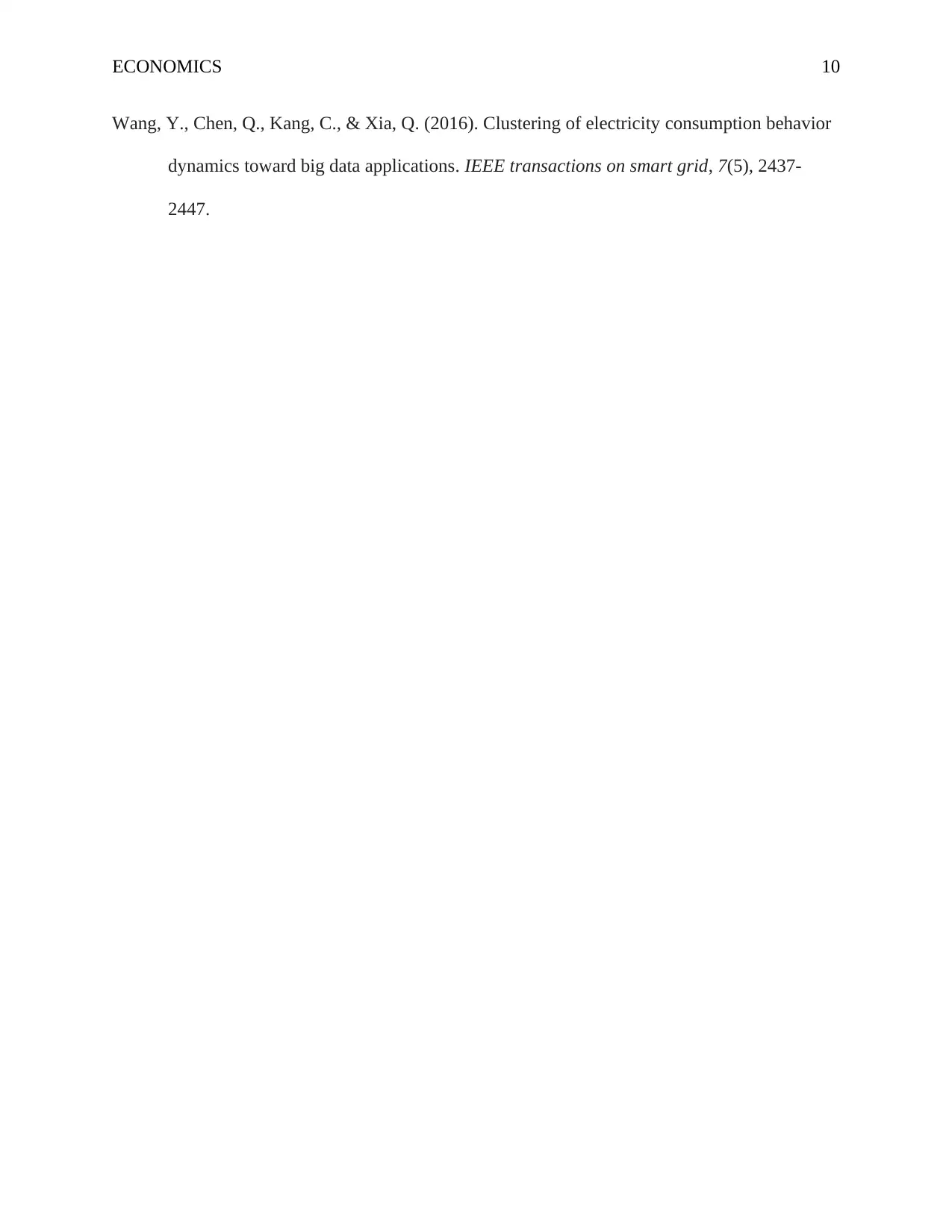
ECONOMICS 10
Wang, Y., Chen, Q., Kang, C., & Xia, Q. (2016). Clustering of electricity consumption behavior
dynamics toward big data applications. IEEE transactions on smart grid, 7(5), 2437-
2447.
Wang, Y., Chen, Q., Kang, C., & Xia, Q. (2016). Clustering of electricity consumption behavior
dynamics toward big data applications. IEEE transactions on smart grid, 7(5), 2437-
2447.
1 out of 10
Related Documents
Your All-in-One AI-Powered Toolkit for Academic Success.
+13062052269
info@desklib.com
Available 24*7 on WhatsApp / Email
![[object Object]](/_next/static/media/star-bottom.7253800d.svg)
Unlock your academic potential
Copyright © 2020–2025 A2Z Services. All Rights Reserved. Developed and managed by ZUCOL.




